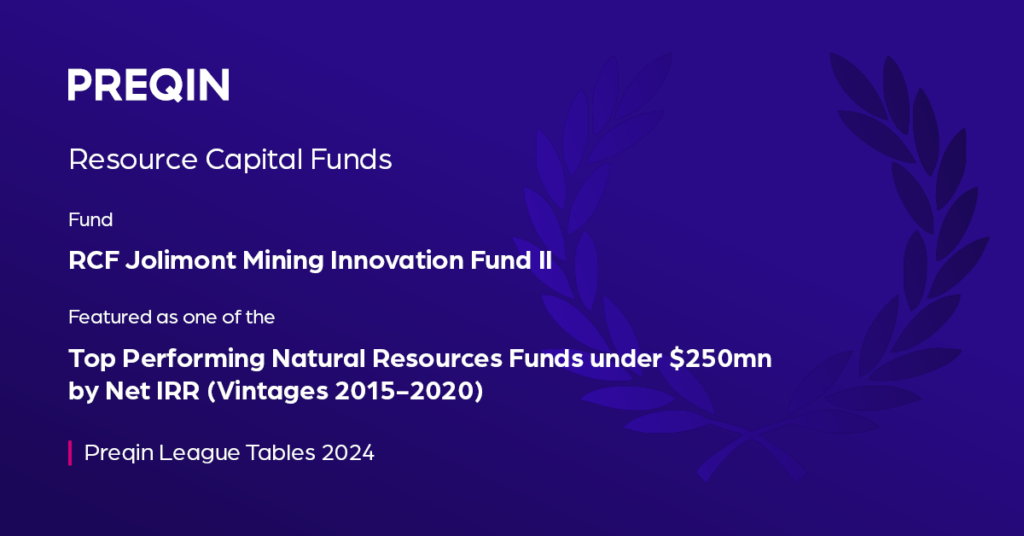Mining has been a cornerstone of human civilization for thousands of years, continuously adopting and adapting to new technology in an effort to improve operations. Despite centuries of progress, the mining industry now confronts new and exciting challenges in order to meet the ever-growing metal and critical mineral supply and demand imbalances that exist today. Historic underinvestment into the mining sector, combined with a paradigm shift in demand driven by the energy transition, AI datacenters, and the permanent need for metals to support manufacturing and industrialization across the globe, are forcing the mining industry, like all corners of the economy, to transform.
Concurrently, new engineering, geological, and technical complexities, combined with cost pressures are unleashing innovation, technological advances, and new ways of thinking that are helping the industry adapt and evolve. These conditions are presenting investment opportunities in an exciting, niche, and growing sector: mining innovation.
The geological and technical challenges faced by the mining industry are increasing as virtually all the planet’s high-grade, easily accessible deposits have already been mined. Mining operations are being forced to drill deeper or build much larger mines—which makes operations inherently more complex and more complicated to scale. Miners are being forced to seek out new deposits in the most remote corners of the globe, making transportation and processing more inefficient and expensive. Simply put, mining companies are forced to find ways to mine lower-grade deposits, in more challenging environments, while remaining economically efficient.
The decline in high-quality, easily accessible deposits intersects with growing demands on the industry to ramp up production. Between now and 2050, the energy transition may require as much as 6.5 billion tons of end-use materials1. It is estimated that 95% will be steel, copper, and aluminum with the rest comprising critical minerals such as lithium, cobalt, zinc, graphite, nickel or rare earths.
Geopolitical concerns are adding to production pressures, as governments are realizing the danger of relying on rival foreign powers for critical minerals. As a result, countries around the world are introducing initiatives designed to advance self-sufficiency. The United States, for example, has passed the CHIPS and Science Act (2022), the Inflation Reduction Act (2022) and the Bi-Partisan Infrastructure Law (2021). While the Trump administration may rollback some incentives built into the Inflation Reduction Act, many dollars have already been deployed for energy infrastructure across different states. Rather than ignoring mineral scarcity, the administration appears more than willing to embrace metals and mining—focused on “mineral dominance” as outlined in Section 9 of his “Unleashing American Energy” executive order. The EU, Canada, Australia and other countries have also passed similar measures. All of these call for significant public and private investment to ramp up domestic production of critical minerals, decrease dependence on global supply chains, and support research and development to advance critical minerals mining strategies and technologies.
The mining industry is also under considerable pressure to address environmental, social, and governance (ESG) concerns, including local community impact, waste and tailings management, worker safety, and mine site carbon emissions. Failing to address them adequately makes attaining a “social license to operate” — the informal but critical acceptance of mining operations by communities, governments, and other stakeholders — more difficult and increases the risk of running afoul of government regulations. More and more, investors and other stakeholders are scrutinizing ESG performance, forcing miners to balance business priorities with ESG goals.
Labor scarcity is driving further change. According to the Society for Mining, Metallurgy & Exploration, more than half the mining workforce in the U.S., about 221,000 workers, is expected to retire by 20292 And despite the fact that mining is projected to consistently add thousands of stable, high-paying jobs over each of the next 20 years, the industry is struggling to attract and retain the workers it needs. Industry leaders are acutely aware that tomorrow’s mines must be substantially different in order to keep pace with this conflicting set of demands.
While mining faces new challenges, it has always been a leader in transformation and innovation. Mining was using autonomous vehicles in the early 2000s, almost a decade before Tesla was even started. In fact, today, innovative companies like Phibion (a portfolio company in RCF Innovation II) is operating at Level 4 autonomy—driverless vehicles.
That said, the mining industry will need to do more (in quantum) to be able to meet global metal and mineral requirements over decades to come.
Mining Innovation
The industry is adapting to this new landscape and evolving quickly. Continuous advances in technology—combined with old-fashioned human ingenuity—are enabling the industry to meet the challenges it faces safely, ethically, and economically.
Innovations in artificial intelligence and machine learning, automation and robotics, data analytics, remote sensing, and more are enabling mines to operate more efficiently and safely, while minimizing environmental impacts. These technologies are revolutionizing every phase of mining, from exploration and extraction to processing and reclamation. Autonomous vehicles and drones are reducing the need for human workers in hazardous and harsh mining conditions, for example, while predictive maintenance systems utilizing AI are minimizing equipment downtime. Moreover, advanced data analytics are optimizing resource allocation and improving decision-making, leading to increased productivity and reduced waste.
Notably, most technological advancements in the industry are not being developed by mining companies themselves. While some mining firms have an innovation capability to support adoption of new approaches, larger mining companies are not always equipped to disrupt themselves and likely cannot focus on developing and marketing new technologies successfully. Most of the innovation is coming from the Mining, Equipment, Technology and Services (METS) sector, which is comprised of companies that sell equipment, supplies, and other products to mining companies. The METS sector was valued at $141 billion in 2023 and is projected to reach $211 billion by 20313. Despite its size and growth, however, many investors have overlooked it. Capital markets have largely been focused on investment opportunities from Silicon Valley, but ignored their applications within mining.
As a sector, METS is an avid consumer of advanced innovation hungry for capital, presenting a niche investment opportunity with growth equity-like return potential.
However, innovative solutions—and even access to capital—aren’t always enough. It is important to nurture these companies, helping them create product differentiation, manage the challenges of early-stage growth, and develop effective distribution markets. RCF Innovation is a growth equity strategy that leverages its reputation as a leading investor in the mining innovation and METS sector—as well as the broader mining industry—to find off-market deals involving small, agile companies with demonstrated products, revenues and growth potential. RCF Innovation aims to help these young companies accelerate their growth through demonstrating the economic value a young company can bring to a miner, creating a platform for growth.
Investments that are Making an Impact
RCF Innovation looks for companies that provide innovative solutions to common challenges across the mining industry, aiming to make mining safer, cleaner and more efficient. The chart below lists current RCF Innovation II investments. From productivity to safety, from mine site decarbonization to cost-savings, entrepreneurial companies like these are applying industry 4.0 technologies to mining. In addition to providing capital, RCF maintains board representation in all of its RCF Innovation II portfolio companies to influence and support successful scale-ups, while aiming to influence the portfolio company’s ability to establish net zero targets. In fact, RCF Innovation II has worked with its portfolio companies to baseline current greenhouse gas emissions and support strategies to reduce emissions. More importantly, these companies are working with their mining customers to identify how the application of these advanced technologies can help the mining operator reduce emissions*.
RCF Innovation II Current Investments**

Australian Droid & Robot develops the Explora Data Acquisition System, which provides mining companies routine, value-efficient control over their data capture. The benefits of the system include improved safety, enhanced data accuracy, continuous operation, increased productivity, and scaleability.
Location
Australia
Innovation
Drones & Robots
Challenge Addressed
Enhanced data collection & accuracy
Improved safety by removing humans from harsh mining environments
Increased speed and efficiency through continuous operation

MEVCO is a systems integrator bringing electric light vehicles to mining. MEVCO is electrifying light vehicles and providing the infrastructure, skills and training to help power a sustainable future by enabling electric light vehicles to be used in the mining sector.
Location
USA & Australia
Innovation
Electric Vehicles
Challenge Addressed
Electrification of large vehicle fleets
Mine site decarbonization
Cost & efficiency savings

Phibion is addressing the problem of mine tailings by providing Accelerated Mechanical Consolidation to extract and recover water and reduce the capacity required in tailings dams. This helps mine operators resolve the issues of today while creating land use opportunities for future generations.
Location
Australia
Innovation
Autonomous vehicles
Advanced mechanical consolidation
Challenge Addressed
Tailings management and environmental impacts
Mine site safety
Cost & efficiency savings

Pitcrew AI is a company developing real-time, automated inspection and condition monitoring solutions, combining computer vision, thermal imaging technology, and advanced AI techniques to enable real-time detection of tire damage and vehicle problems.
Location
Australia
Innovation
AI and Industrial Internet of Things (IIOT)
Challenge Addressed
Mine site decarbonization
Mine site safety
Cost & efficiency savings

Railveyor is an innovation company that designs and manufactures fully autonomous, emissions- and battery-free material hauling systems for underground and surface mining. Railveyor is a low-cost and low CO2 emitting solution for ore haulage.
Location
Canada
Innovation
Fully electric, fully autonomous material haulage
Challenge Addressed
Mine site decarbonization
Mine site safety
Cost & efficiency savings

Real Time Instruments has developed a suite of elemental analyzers and moisture analyzers that empower customers with accurate, immediate and targeted visibility over their bulk material operations. RTI measures the composition of bulk materials moving at speed on conveyors in real time.
Location
Canada
Innovation
Data analytics
Advanced sensors
Elemental, moisture & microwave analyzers
Challenge Addressed
Mine site decarbonization
Mine site safety
Cost & efficiency savings

VRIFY has developed an AI tool that improves the targeting of exploration drilling. It helps mining companies unlock the full potential of investor and stakeholder engagement through groundbreaking interactive 3D and 360-degree presentations.
Location
Canada
Innovation
AI exploration drill targeting and 3D Imaging
Challenge Addressed
Cost & efficiency savings
Generating Alpha: A Niche Sector with Upside
Building a successful business that supports mining operations requires a deep understanding of the industry.
These early growth innovators need more than capital. They also need commercial expertise, networks, and end-markets to sell their innovations to, and access to experienced teams with the entrepreneurial experience and growth mindset needed to scale companies effectively. That’s why they look to RCF Innovation, which is led by a group of experienced entrepreneurs with expertise in both mining and innovation.
While many investors are lining up to deploy capital in support of AI at the 10,000-foot Silicon Valley level, relatively few dollars are flowing into the ground-level mining innovation and METS sector. This creates significant opportunities for knowledgeable investors, who can recognize how those technologies can be effectively—and profitably—deployed in the mining sector.
With a strong exit market backed by strategic acquirers readying themselves for critical mineral production ramp-up, mining innovation is ready for capital and commercialization. RCF Innovation strives to position itself to generate outsized returns for investors by leveraging its reputation as a leading investor in mining innovation, and aims to be the preferred partner for fast-growing, innovation companies.
Preqin-recognized Performance*
Recently, Preqin recognized the team’s performance when comparing IRR by vintages: 2015 – 2020:

*This Preqin Badge was awarded to the RCF Jolimont Mining Innovation Fund II (the “Fund”) on April 18, 2024, by Preqin, a provider of comprehensive alternative assets data. It reflects a ranking of 1,194 natural resources funds of similar size (under $250 mm) and similar vintage (2015-2020) in Preqin’s database. The performance period used by Preqin for the Fund is from its inception on December 21, 2020, through March 31, 2024 (note: RCF provided Preqin with Fund performance data through September 30, 2023). No compensation has been provided by Resource Capital Funds or its affiliates in connection with obtaining or using this Preqin rating. Third-party ratings and recognition do not guarantee future investment success and do not ensure a higher level of performance or results.
Like what you’re reading? Subscribe to our top stories.
Source of Data
1 Energy Transitions Commission, New Report: Scale-up of critical materials and resources required for energy transition. https://www.energy-transitions.org/new-report-scale-up-of-critical-materials-and-resources-required-for-energy-transition/
2 Society for Mining, Metallurgy and Exploration, Workforce Trends in the U.S. Mining Industry. https://www.smenet.org/What-We-Do/Technical-Briefings/Workforce-Trends-in-the-US-Mining-Industry
3 SkyQuest Technology, Mining Equipment Market Trends, Size, Share & Forecast 2024-2031. https://www.skyquestt.com/report/mining-equipment-market
Important Information
*Please visit resourcecapitalfunds.com/transparency and download RCF’s 2024 ESG Annual Report for more specific details on greenhouse gas emissions monitoring for RCF Innovation II.
**This represents the portfolio of RCF Jolimont Mining Innovation Fund II L.P. (RCF Innovation II).
This material is provided for educational purposes only and should not be construed as research.
The opinions expressed may change as subsequent conditions vary. The information and opinions contained in this material are derived from proprietary and non-proprietary sources deemed by Resource Capital Funds and/or its affiliates (together, “RCF”) to be reliable. No representation is made that this information is accurate or complete. There is no guarantee that any forecasts made will come to pass. Reliance upon information in this material is at the sole discretion of the reader.
None of the information constitutes a recommendation by RCF, or an offer to sell, or a solicitation of any offer to buy or sell any securities, product or service. The information is not intended to provide investment advice. RCF does not guarantee the suitability or potential value of any particular investment. The information contained herein may not be relied upon by you in evaluating the merits of any investment.
Investments can be subject to market risk, the value of which may be volatile and fluctuate in response to the activities and performance of individual companies or because of investment sentiment, political environment, general market and economic conditions, regional and global instability and changes in currency exchange rates and interest rates.
Investing involves risk, including possible loss of principal.



